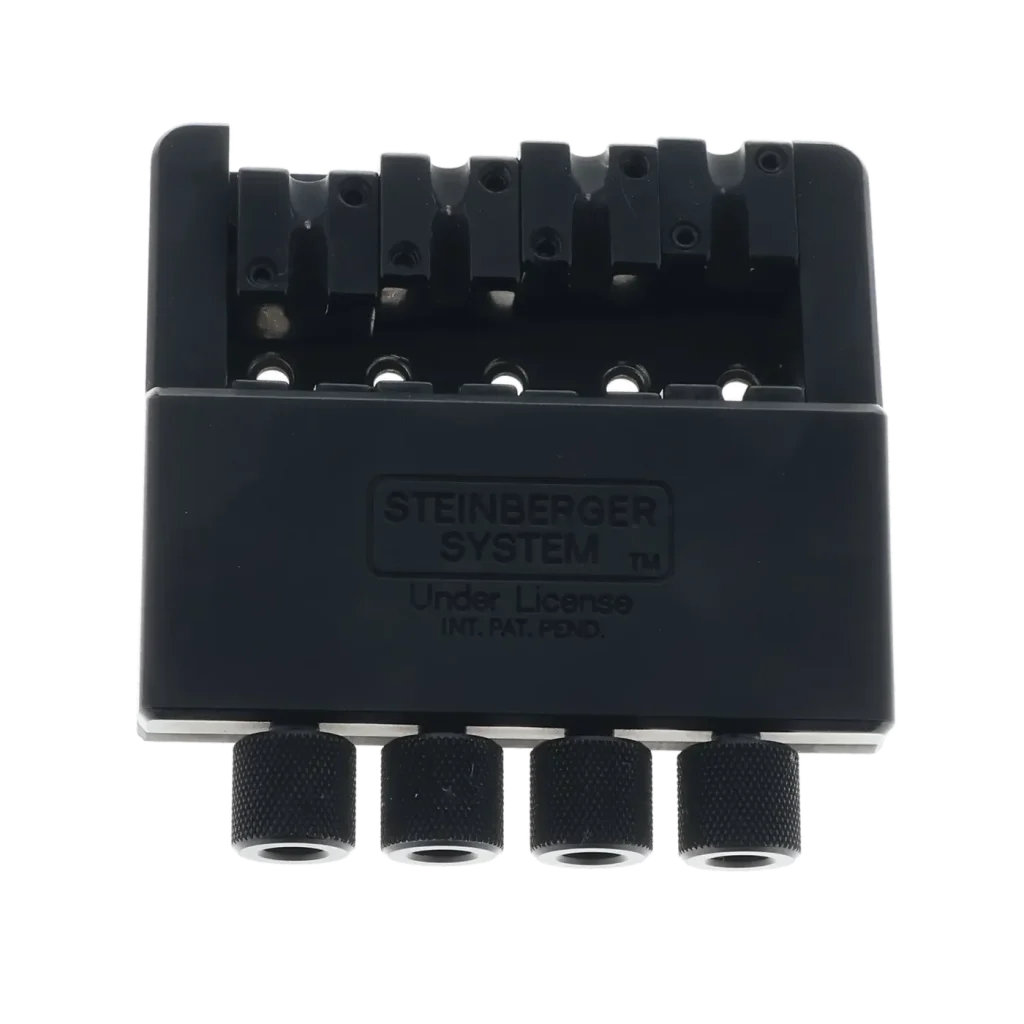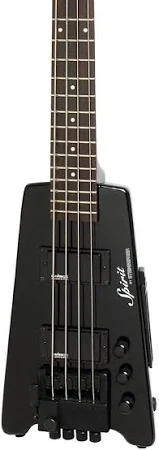The Ultimate Guide to Action, String Height, and Intonation: Steinberger Spirit Bass
I got my first Steinberger Spirit bass around 2002. It didn’t take long before I set aside some greatly revered basses and started playing it often. I loved the lack of weight and it sounded great.
Adjusting a Steinberger Spirit bass action, string height, and intonation is a whole different ball game compared to setting up a standard Fender or Gibson. If you’re not prepared, you might find yourself pulling your hair out in frustration.
But once you understand the quirks and unique features of this incredible instrument, you’ll be able to dial in a setup that’ll make your Steinberger sing like never before.
Understanding the Steinberger Spirit’s Unique Design
It’s crucial to understand what makes the Steinberger Spirit bass so special. The headless design fundamentally changes how we approach setup and adjustment.
However, when you do need to make changes, they can have a more dramatic effect on playability. Then there’s the matter of those double-ball strings. They’re not just a quirky design choice – they affect string tension and, by extension, your entire setup process.
The Truss Rod: Your First Line of Defense
When it comes to setting up any bass, the truss rod is where the magic begins. On a Steinberger Spirit, you’ll find the truss rod access at the body end of the neck.
- Use a suitable Allen wrench – don’t try to wing it with the wrong tool.
- Turn clockwise to tighten (reduce relief), counterclockwise to loosen (increase relief).
- Aim for a slight forward bow, typically around 0.010″ at the 7th fret.
Bridging the Gap: Adjusting String Height and Action
The bridge on a Steinberger Spirit bass is a work of art in itself. With individual saddles for each string, you have unprecedented control over your string height and action.
Here’s how to make the most of it:
- Use Allen wrenches to raise or lower each saddle.
- Measure string height at the 12th fret.
A good starting point is 2.0mm for the 1st string, gradually increasing to 2.5mm for the 4th string.
- Adjust for your personal preference and playing style.
Slap bassists might prefer slightly higher action, while shredders might opt for a lower setup.
- Ensure even string spacing and consistent height across all strings.
Pro Tip: Don’t be afraid to experiment with different string heights. The beauty of the Steinberger design allows for incredibly low action without introducing fret buzz, thanks to its superior neck stability.
I’ve been able to get my action down to 1.5mm on the treble side without any buzzing – something I’d never dream of on my other basses.
The Nut: Often Overlooked, Always Important
Even though Steinberger Spirit basses don’t have a traditional nut, the string slots at the body end of the neck play a similar role. Here’s what to look out for:
- Check for proper string seating in the slots.
- If the slots are too high, carefully file them down using suitable nut files.
- Ensure strings don’t bind in the slots – this can affect tuning stability and intonation.
Any adjustments made here will have a significant impact on playability and intonation, so proceed with caution. I once made the mistake of filing these slots too low, and it took me weeks to get my intonation back in check.
Intonation: The Final Frontier
- Use a reliable tuner to check pitch at the 12th fret harmonic and fretted note.
- Adjust individual bridge saddles:
- Move the saddle forward if the fretted note is sharp.
- Move the saddle backward if the fretted note is flat.
- Retune and recheck after each adjustment.
- Pay special attention to the R-Trem system if present, as it can affect intonation stability.
Key Insight: The short scale length of some Steinberger models can make intonation more sensitive. Take your time and be precise with your adjustments.

Fine-Tuning: The Devil’s in the Details
Once you’ve got the basics dialed in, it’s time for some fine-tuning:
- Check for fret buzz across the entire fretboard.
- Make minor truss rod adjustments if needed.
- Ensure proper string seating at the bridge and nut.
- Verify tuning stability, especially with the R-Trem system.
Don’t forget about pickup height! Set it for optimal output and string-to-string balance.Typically, you’ll want the bass side slightly higher than the treble side.I usually start with the pickups about 3mm from the strings when fretted at the last fret, then adjust to taste.
String Selection: More Than Just a Matter of Taste
Choosing the right strings for your Steinberger Spirit is crucial. You’re dealing with double-ball strings here, which limits your options somewhat.
However, there are still plenty of choices to consider:
- Gauge: As mentioned earlier, gauge can significantly affect your tone and playability.
Don’t be afraid to experiment.
- Material: Nickel-plated steel is standard, but you might want to try stainless steel for brighter tone or pure nickel for a warmer sound.
- Roundwound vs. Flatwound: While roundwounds are more common, flatwounds can give you a smooth, vintage tone that works great with the Steinberger’s modern design.
- Brand: D’Addario and LaBella are popular choices, but there are other brands making double-ball strings now.
Try a few to see what works best for you.
I’ve found that D’Addario EXL170 strings (.045-.100) strike a nice balance for me, but your mileage may vary.
Pickup Adjustment: Fine-Tuning Your Tone
While not strictly part of the physical setup, adjusting your pickups can have a huge impact on your tone and playability:
- Height: Start with the pickups about 3mm from the strings (when fretted at the last fret) and adjust from there.
Lower pickups will give you a smoother, more vintage tone, while raising them will increase output and add more bite.
- Angle: Experiment with angling your pickups.
Typically, you’ll want the bass side slightly higher than the treble side, but don’t be afraid to try different angles to shape your tone.
- Balance: Adjust the height of each pickup relative to the other to balance your tone across different pickup selections.
- Pole pieces: If your Steinberger has adjustable pole pieces, use these for fine-tuning the output of individual strings.
I like to set my bridge pickup slightly higher than my neck pickup. This gives me a nice, punchy tone for slap and pop techniques when I choose the bridge pickup alone.
Maintaining Your Setup
Once you’ve got your Steinberger Spirit dialed in perfectly, you’ll want to keep it that way. Here are some maintenance tips:
- Regular cleaning: Wipe down the strings and fretboard after each playing session.
This will extend string life and keep your fretboard in good condition.
- Check tuning and intonation regularly: Even with the stability of the graphite neck, things can shift over time.
- Keep an eye on hardware: Check that all screws and bolts are tight, especially on the bridge and tuners.
- Seasonal adjustments: While the Steinberger is more stable than most basses, you might still need slight adjustments as the seasons change.
- Re-setup after string changes: Every time you change strings, go through at least a basic setup process.
New strings can change the tension on the neck and affect your action and intonation.so.
Troubleshooting Common Issues
Even with the best setup, you might encounter some issues. Here are some common problems and their solutions:
- Persistent fret buzz: If you’re getting buzz even with proper relief and action, you might have an uneven fret.
Consider a fret level and crown.
- Tuning instability: Check the string slots at the headpiece and bridge.
Make sure the strings are seated properly and not binding.
- Dead spots: Some notes that sound dull or die quickly could indicate a resonance issue.
Try changing your string gauge or adjusting neck relief.
- Uneven volume across strings: This is often a pickup height issue.
Adjust your pickup angle or individual pole pieces if available.
- R-Trem not returning to center: Check and adjust the spring tension.
You might also need to lubricate the pivot points.
I once had a persistent buzz on my G string that drove me crazy for weeks. Turned out it was a slightly high fret that needed leveling.
Don’t be afraid to seek professional help if you can’t solve an issue on your own.
The Importance of Regular Setup
A well-set-up Steinberger Spirit bass is a joy to play. It’s responsive, stays in tune, and allows you to express yourself freely without fighting the instrument.
But like any precision instrument, it needs regular attention to stay in top form.
I make it a point to go through my full setup process at least twice a year, and I do quick checks much more often. This might seem like a lot of work, but it pays off in improved playability and tone.
It revolves around creating an instrument that feels like an extension of yourself, that responds to your touch exactly the way you want it to. Take the time to really get to know your bass, to understand how each adjustment affects its feel and sound.
Frequently Asked Questions
How often should I adjust the truss rod on my Steinberger Spirit bass?
You should check your truss rod every few months or whenever you notice significant changes in your playing feel. However, because of the stability of the graphite neck, you may find you need to adjust it less often than with traditional wood-necked basses.
Can I use regular bass strings on a Steinberger Spirit?
No, Steinberger Spirit basses require special double-ball end strings. Regular bass strings will not fit or function properly on this instrument.
What’s the ideal string height for a Steinberger Spirit bass?
The ideal string height varies depending on your playing style, but a good starting point is about 2mm at the 12th fret for the low E string, gradually decreasing to about 1.5mm for the G string.
How do I adjust the intonation on a Steinberger Spirit bass with an R-Trem system?
Adjusting intonation on an R-Trem equipped Steinberger is similar to a standard bridge, but you’ll need to confirm the tremolo is balanced and returning to the neutral position. Adjust the individual saddles while checking the pitch of the 12th fret against the 12th fret harmonic.
Are Steinberger Spirit basses good for beginners?
While Steinberger Spirit basses are excellent instruments, their unique design and setup requirements might be challenging for absolute beginners. However, if you’re willing to learn about proper setup and maintenance, they can be rewarding instruments for players of all levels.
How does the graphite neck of a Steinberger Spirit affect its sound?
The graphite neck provides excellent sustain and a clear, articulate tone. It also contributes to the instrument’s stability, reducing the need for frequent adjustments because of temperature and humidity changes.
Can I install aftermarket pickups on my Steinberger Spirit bass?
While it’s possible to install aftermarket pickups on a Steinberger Spirit, the unique design of the instrument may limit your options. It’s best to talk to a professional luthier before attempting any such modifications.
How do I clean and maintain the phenolic fretboard on my Steinberger Spirit?
The phenolic fretboard is very durable and low-maintenance. Simply wipe it down with a slightly damp cloth after playing.
For deeper cleaning, you can use a small amount of specialized fretboard cleaner, but avoid using oils or conditioners as you would on a wood fretboard.
What’s the advantage of the headless design on Steinberger Spirit basses?
The headless design offers several advantages including improved balance, reduced weight, and increased tuning stability. It also allows for a more compact instrument, which can be useful for travel or playing in tight spaces.
How does the scale length of a Steinberger Spirit compare to traditional basses?
Steinberger Spirit basses typically have a scale length of 32″ or 34″, which is comparable to many traditional bass guitars. However, the lack of a headstock makes the overall instrument length significantly shorter.
Key Takeaways
- The Steinberger Spirit’s unique design needs a specialized approach to setup.
- The graphite neck offers superior stability but responds differently to adjustments.
- Double-ball strings and the R-Trem system add complexity to the setup process.
- Precise intonation is crucial because of the short scale length of some models.
- Regular fine-tuning is essential to maintain optimal playability and tone.




